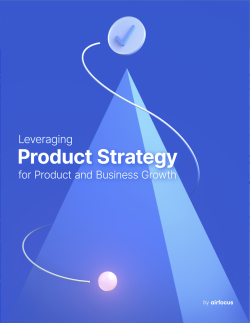Market Development Strategy
What is a Market Development Strategy
Market Development Strategy Definition
Market Development Strategy is a growth strategy put in place by companies or organizations to introduce their product or solution to target audiences they have not yet reached or are not yet currently serving.
For example, let’s say your software company has a new product offering.
In order to come up with a market development strategy, you need to research who the new product would work best for, and the best way to target them — that, in a nutshell, will be your market development strategy.
Examples of market development strategies
Here are a few popular market development strategies:
Geographic expansion
One way to reach a new audience with your product is by geographic expansion.
For example, If you’re currently only targeting US customers, research what it might take for your company to expand your audience on a global level.
Or, if you’re currently only serving tech companies in New York City, research whether or not it would make sense to target San Francisco tech companies as well.
Upselling to existing customers
If all, or some, of your current customer base, could benefit from your new product offering, consider using your relationship with them as a gateway to introducing your new solution.
Attracting non-users
Along with (or separate from) upselling to current customers or clients, you can also develop a plan to target non-users of your product. This can be achieved through a variety of methods, including offering free trials, cold outreach, advertising, etc.
Attracting competitors’ customers
Who else is making a product like yours? And how can you convince their customers to migrate to you? Maybe you can adjust your pricing, offer incentives or discounts, use lookalike audiences in advertising, or deliver a superior user experience.
Where does market development fall in the Ansoff Matrix?
The Ansoff Matrix (often referred to as the product/market expansion grid) is a framework used to identify growth opportunities and conceptualize their risk level. It’s a fundamental framework used by businesses across the globe because it offers a simple yet intuitive way to visualize the feasibility of new ideas.
Market development focuses on selling existing products into new markets, placing them in the bottom left quadrant of the Ansoff Matrix. This is the second least risky growth strategy in the Ansoff model. The only better growth strategy on the Ansoff Matrix is market penetration, which sees existing products introduced into an existing market.
Examples of market development strategies based on industry
Slack (SaaS)
Slack’s success as a communication platform for businesses was inevitable, given that it started as an internal company tool. They could rigorously test a live product without releasing it to the public. This was integral to Slack’s market development strategy, which revolves around using real user behaviors to guide their development and marketing efforts.
By using real user data and listening to what users needed, Slack was able to make slight adjustments to its platform to bring in more users.
Uber (SaaS/transportation)
Uber started as a small business serving the residents of San Francisco. They focused on perfecting the service before branching out to new markets, making it easier to enter new markets once they were ready. Being able to bring a fully fleshed-out product to new markets, coupled with its unique diversification strategy, has helped them become the global powerhouse they are today.
NBA (non-SaaS/sports entertainment)
While the National Basketball Association is a powerhouse in the US, its international efforts have struggled. The mass global appeal of soccer made it clear that there is an appetite for sports worldwide, leading to both the NBA and NFL attempting to expand into international territories.
It took years of negotiations and significant resource investment for the NBA to bring the league to China, but it paid off. The NBA implemented its marketing development strategy to bring televised games to China, becoming the country's most popular sports league.
Starbucks (non-SaaS/food and drink)
Starbucks has a very aggressive market development strategy. With a solid business model and product offering, the company has focused heavily on entering new markets. They have focused on deep market penetration to ensure success by building a worldwide franchise.
Challenges and obstacles to successful market development
There are several challenges and obstacles to keep in mind when launching a successful market development strategy. Here are just a few.
Competition
When entering a new market, you’ll need to compete with established players who already have market share.
To overcome this challenge, you must develop and fine-tune your unique value proposition that stands outs and resonates with your target customer.
Changing customer needs
Customer needs and preferences constantly evolve, making it challenging for companies to keep up. Collecting customer feedback and doing market research is the best way to know what your customers need.
Good market research helps you stay up-to-date on customer trends and behavior. When you know what your customers want, you can adapt your product offerings and marketing messages to meet your target market's needs.
Regulatory barriers
If you’re entering a new market in another part of the world from where you usually operate, you should look out for any regulatory barriers. For example, regulations around accepting payments can hinder your market development plan.
You should work with local legal experts to understand the regulatory landscape and ensure you stay compliant. This can include obtaining necessary permits and licenses and adhering to product safety standards.
Lack of brand recognition
Building brand recognition takes time when entering a new market. Customers like to buy from brands they trust and are likely unfamiliar with your brand.
When you enter a new market, you’ll need to invest in marketing and advertising efforts that build brand awareness and trust. This can include targeted digital advertising, social media campaigns, and public relations efforts highlighting your product's unique value proposition.
Creating a market development strategy: Step-by-step Process
Before implementing new tactics, you should follow this step-by-step process to create an effective, well-thought-out market development plan.
Conduct market research
Your market development strategy should always start with market research. You need to know your target customers and current market conditions.
Surveying your current customers is one of the best market research methods. This works particularly well when you are expanding an existing product line.
Set goals
Set goals that are measurable, achievable, relevant, and time-bound (SMART).
Some examples include:
Increase sales by 50%
Increase net profit by 20% by cutting costs
Increase monthly active users by 10% each quarter
Goals should directly align with your market development strategy. The objective when entering a new market is growth and ROI, so your goals should be focused on both metrics.
Look at available resources
Once you’ve analyzed the market and set goals, you can evaluate your current resources. Ask yourself a few critical questions before building your marketing plan.
Do we have a big enough budget to reach this market?
How much time do we have to allocate to this new launch?
How many employees are needed to enter this new market successfully?
If you notice a shortcoming, adjust where you allocate your resources to increase your chances of achieving your goals.
Create a marketing plan
Now you can start focusing on specific strategies by creating a marketing plan. This plan should include the exact method you want to use to reach your target market. The marketing plan should include the following:
Key strategies (email, social media, SEO, paid ads, etc.)
Events & PR strategies
This can also include what distribution channels you plan to use. For example, social media marketing would mean using Facebook, Instagram, and Twitter as your distribution channels.
Analyze your launch
Finally, you are ready to go to market. But first, you should analyze your launch to confirm your research and planning are thorough and accurate.
Your team should be completely aligned on the strategy and marketing plan.
After launch, monitor key performance metrics and explore the results. Ask yourself important questions by revisiting your goals. Are you meeting your sales goals? Do you need more team members? Prioritize collecting data as early as possible and make changes to the parts of your strategy that aren’t working.
Things to consider when creating a new market development strategy
There are several factors to consider when determining if your company is ready to develop a new market development strategy for your product:
Is there a specific target audience (market) you’re not yet serving? Would this audience truly benefit from your new product offering?
Do you, or your team, have the bandwidth to develop and measure the effectiveness of a market development strategy?
Will your effort in reaching this new market be worth the investment from your company or organization? (What is the ROI?)
Benefits of a market development growth strategy
Market development strategies are the key to growth.
While it can feel more comfortable for businesses to continue to cater to their existing niche customer base, it prevents any opportunity for scale.
A market development growth strategy helps businesses guide their efforts in a way that grows the business and drives market development.
This is achieved with proper risk management and in-depth market research to help avoid common pitfalls found when trying to grow a business.
Market development stages
Before you start crafting a market development growth strategy, it’s better to understand the journey you have ahead.
There are four key market development stages. By following the stages, businesses can easily enter a new market and grow their business.
Stage one: Define
Before a business can enter a new market, they need to know what that market is and who they need to target to achieve market penetration.
The first of the market development stages involves identifying the customer — that way, businesses can better plan their strategy using insights from the defined target audience.
Stage two: Research
Of course, to utilize insights, you first need to find the data that can give you them. Businesses should perform thorough market research that relates to their customers and products.
This includes information on customer habits, competitor products, why customers use your competitors, and what those competitors are lacking.
Stage three: Weigh up your options
With all the information you need in front of you, you can make an informed decision on whether the market is worth pursuing.
There will always be a risk to entering a new market, but by defining your audience and researching the market, you can lessen that risk by looking at a range of variables.
Stage four: Plan
If your research analysis shows potential, it’s time to plan how you’re going to enter the new market. This is the last of our market development stages and involves looking at how you will promote this new venture, how it will work, and how to continue to grow once you have established a presence in the market.
Common mistakes when creating a Market development strategy
Marketing development is tough, and you’re bound to make mistakes. Here are some of the most common mistakes we see when creating a market development strategy:
Following trends and copying other businesses’ marketing development strategy
Focusing on the wrong KPIs or ignoring KPIs altogether
Ignoring your customers
Failing to perform enough research
Creating overly complex marketing development strategies
Forgetting to include flexibility
Not considering delivery
Not creating a go-to-market team

General FAQ

Glossary categories
Create effective product strategy

Experience the new way of doing product management








